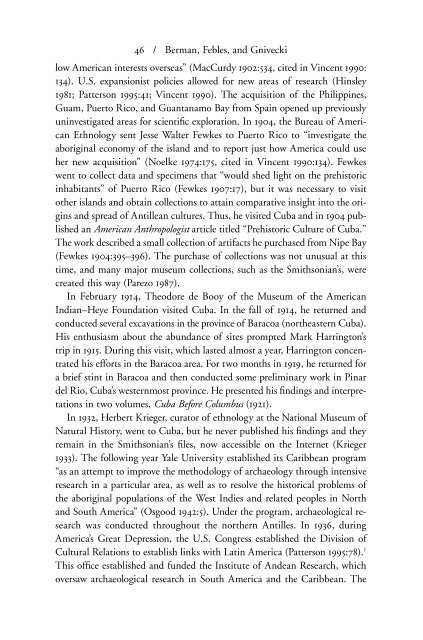Dialogues in Cuban Archaeology
by L. Antonio Curet, Shannon Lee Dawdy, and Gabino La Rosa Corzo
by L. Antonio Curet, Shannon Lee Dawdy, and Gabino La Rosa Corzo
You also want an ePaper? Increase the reach of your titles
YUMPU automatically turns print PDFs into web optimized ePapers that Google loves.
46 / Berman, Febles, and Gnivecki<br />
low American <strong>in</strong>terests overseas” (MacCurdy 1902:534, cited <strong>in</strong> V<strong>in</strong>cent 1990:<br />
134). U.S. expansionist policies allowed for new areas of research (H<strong>in</strong>sley<br />
1981; Patterson 1995:41; V<strong>in</strong>cent 1990). The acquisition of the Philipp<strong>in</strong>es,<br />
Guam, Puerto Rico, and Guantanamo Bay from Spa<strong>in</strong> opened up previously<br />
un<strong>in</strong>vestigated areas for scienti¤c exploration. In 1904, the Bureau of American<br />
Ethnology sent Jesse Walter Fewkes to Puerto Rico to “<strong>in</strong>vestigate the<br />
aborig<strong>in</strong>al economy of the island and to report just how America could use<br />
her new acquisition” (Noelke 1974:175, cited <strong>in</strong> V<strong>in</strong>cent 1990:134). Fewkes<br />
went to collect data and specimens that “would shed light on the prehistoric<br />
<strong>in</strong>habitants” of Puerto Rico (Fewkes 1907:17), but it was necessary to visit<br />
other islands and obta<strong>in</strong> collections to atta<strong>in</strong> comparative <strong>in</strong>sight <strong>in</strong>to the orig<strong>in</strong>s<br />
and spread of Antillean cultures. Thus, he visited Cuba and <strong>in</strong> 1904 published<br />
an American Anthropologist article titled “Prehistoric Culture of Cuba.”<br />
The work described a small collection of artifacts he purchased from Nipe Bay<br />
(Fewkes 1904:395–396). The purchase of collections was not unusual at this<br />
time, and many major museum collections, such as the Smithsonian’s, were<br />
created this way (Parezo 1987).<br />
In February 1914, Theodore de Booy of the Museum of the American<br />
Indian–Heye Foundation visited Cuba. In the fall of 1914, he returned and<br />
conducted several excavations <strong>in</strong> the prov<strong>in</strong>ce of Baracoa (northeastern Cuba).<br />
His enthusiasm about the abundance of sites prompted Mark Harr<strong>in</strong>gton’s<br />
trip <strong>in</strong> 1915. Dur<strong>in</strong>g this visit, which lasted almost a year, Harr<strong>in</strong>gton concentrated<br />
his efforts <strong>in</strong> the Baracoa area. For two months <strong>in</strong> 1919, he returned for<br />
a brief st<strong>in</strong>t <strong>in</strong> Baracoa and then conducted some prelim<strong>in</strong>ary work <strong>in</strong> P<strong>in</strong>ar<br />
del Rio, Cuba’s westernmost prov<strong>in</strong>ce. He presented his ¤nd<strong>in</strong>gs and <strong>in</strong>terpretations<br />
<strong>in</strong> two volumes, Cuba Before Columbus (1921).<br />
In 1932, Herbert Krieger, curator of ethnology at the National Museum of<br />
Natural History, went to Cuba, but he never published his ¤nd<strong>in</strong>gs and they<br />
rema<strong>in</strong> <strong>in</strong> the Smithsonian’s ¤les, now accessible on the Internet (Krieger<br />
1933). The follow<strong>in</strong>g year Yale University established its Caribbean program<br />
“as an attempt to improve the methodology of archaeology through <strong>in</strong>tensive<br />
research <strong>in</strong> a particular area, as well as to resolve the historical problems of<br />
the aborig<strong>in</strong>al populations of the West Indies and related peoples <strong>in</strong> North<br />
and South America” (Osgood 1942:5). Under the program, archaeological research<br />
was conducted throughout the northern Antilles. In 1936, dur<strong>in</strong>g<br />
America’s Great Depression, the U.S. Congress established the Division of<br />
Cultural Relations to establish l<strong>in</strong>ks with Lat<strong>in</strong> America (Patterson 1995:78). 1<br />
This of¤ce established and funded the Institute of Andean Research, which<br />
oversaw archaeological research <strong>in</strong> South America and the Caribbean. The


















